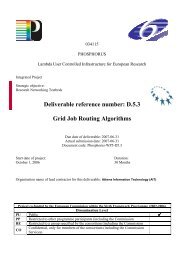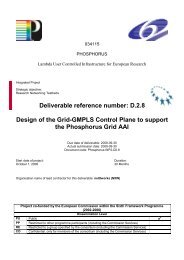D5.9: Extended Simulation Environment - Phosphorus
D5.9: Extended Simulation Environment - Phosphorus
D5.9: Extended Simulation Environment - Phosphorus
You also want an ePaper? Increase the reach of your titles
YUMPU automatically turns print PDFs into web optimized ePapers that Google loves.
D5.6 - <strong>Extended</strong> <strong>Simulation</strong> <strong>Environment</strong><br />
Moreover, at the beginning of the simulation a given number of datasets are generated and two copies of each<br />
dataset are distributed in the network; the first is distributed among the Tier 1 sites and the second is placed at<br />
Tier 0 site (we assumed a hierarchical data resource architecture, which consists of two Tiers). Since the<br />
storage capacity is bounded, there are cases where a site does not have the free storage capacity required to<br />
store a needed dataset. In such a case, one or more of the oldest and unused datasets are deleted until the<br />
new dataset can be stored at the resource.<br />
In all our experiments we keep constant the average total data size S that each job requires:<br />
S L V I<br />
, (1)<br />
where L is the number of datasets a job requests and V I is the average size of each dataset. The job workload<br />
W correlates with the average total data size S, through parameter a, as:<br />
W a S . (2)<br />
As a increases, the jobs become more CPU-intensive, while as a decreases the jobs have less computation<br />
demands. Also, when a job completes its execution we assume that there is no output data returned to the<br />
originating user.<br />
We have implemented the following metrics to measure the performance of the DC algorithms examined:<br />
The average job delay, which is the time that elapses between the creation of a job and the time its<br />
execution is completed at a site.<br />
The average load per job imposed to the network, which is the product of the size of datasets<br />
transferred and the number of hops these datasets traverse.<br />
The job success ratio: This is the ratio of the number of jobs that where successfully scheduled, over<br />
the total number of jobs generated. When a large number of jobs are queued or under execution, it may<br />
be impossible for the scheduler to find a resource with sufficient free storage space, where a new job‟s<br />
datasets can consolidate. In this case the job cannot be scheduled and is counted as a failure.<br />
The Data Consolidation (DC) probability, which is the probability that the selected DC site will not have<br />
all the datasets required by a job and as a results Data Consolidation will be applied.<br />
The first metric characterizes the performance of the DC strategy in executing a single job, while the second<br />
and the third express the overhead the DC strategy induces to the network. The fourth metric gives information<br />
on the way the DC site is selected, with respect to the datasets that are located (or not) at this DC site.<br />
2.4 Installing and using the gridNs module<br />
In order to use the gridNS module one must follow the following steps:<br />
1. Install the ns-allinone software package: http://www.isi.edu/nsnam/ . Our module was tested with<br />
version 2.31.<br />
Project:<br />
<strong>Phosphorus</strong><br />
Deliverable Number: <br />
Date of Issue: 2009-03-31<br />
EC Contract No.: 034115<br />
Document Code: <br />
12






